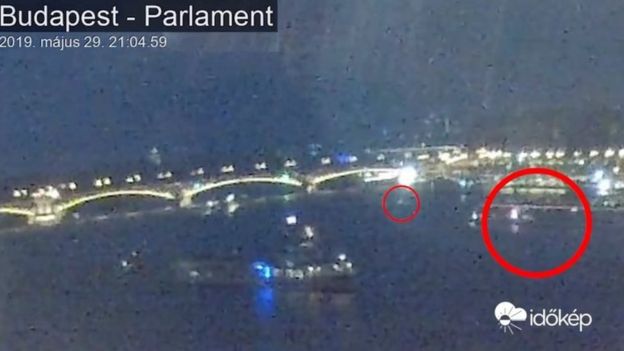
- Seven South Korean tourists have died and another 21 people are missing after a boat sank on the Danube river in Hungary's capital, Budapest.
Seven South Korean tourists have died and another 21 people are missing after a boat sank on the Danube river in Hungary’s capital, Budapest.
Thirty South Korean tourists and three tour guides, as well two Hungarian crew, were on the boat when it and another vessel collided.
The incident occurred at about 22:00 local time (20:00 GMT) on Wednesday.
Seven people have been rescued, and a massive search operation is continuing on a river swollen by heavy rainfall.
The rain had led to strong currents on the Danube, a popular draw for tourists.
Rescue teams say there is little hope of finding any more survivors.
A criminal investigation has been launched.
What is known about the incident?
The boat that sank near the parliament building in central Budapest was identified as the Hableany, or Mermaid.
The Hableany has two decks and a capacity of 45 people for sightseeing trips.
CCTV footage has emerged purportedly showing the Hableany and a larger vessel colliding near the Margit (Margaret) Bridge.
Some reports suggest that the Hableany was hit from behind.
This has not been confirmed by the Hungarian authorities, as they investigate a rare incident on the Danube, where navigation is busy but generally safe.
At a news conference on Thursday, police spokesman Adrian Pal said the boat had sunk almost immediately after the collision, Reuters reports.
Meanwhile, Imre Horvath, the head of the Hungarian National Shipping Association, said he believed it was a human error, MTI news agency reported, although he gave no further details.
How has South Korea reacted?
South Korea’s foreign ministry confirmed that seven of its citizens had died and 19 were missing.
Hungarian police officials later said 21 people were unaccounted for, but it was unclear whether this included any tour guides and crew members.
The South Korean ministry said a team of officials would be sent to Hungary, adding that counselling would be made available to victims’ families.
At a press conference in the South Korean capital, Seoul, a spokesman for the travel agency behind the group’s tour, Lee Sang-moo, said at least one child was among the missing.
Pal Gyorfi, a spokesman for Hungarian emergency services, was quoted as saying that seven people had been pulled from the water.
He said they had been taken to hospital with “hypothermia and shock symptoms”.
The large rescue effort continued throughout the night and into Thursday morning, with boats, divers, spotlights, and radar scanning along the river several kilometres downstream.
Emergency crews have discovered the wreckage of the Mermaid on the riverbed after searching for several hours near the Margaret Bridge, local media said.
Rescue teams warned that, as more time passed, the strong currents would carry people further downstream, lessening the chances of finding survivors.
Boat traffic has been halted on the Danube south of Budapest, Reuters news agency reported.
Why does the incident resonate with South Koreans?
The BBC’s Laura Bicker in Seoul says Wednesday’s sinking on the Danube is a painful reminder of the Sewol disaster in 2014.
The ferry of that name sank off the south-western island of Jindo, killing 304 people, almost all of them schoolchildren on a trip.
The sinking was blamed on a combination of illegal redesigns, cargo overloading, the inexperience of the crew member steering the vessel, and lax government regulations.
The ship’s captain was later convicted of murder.



